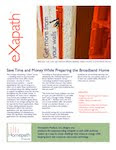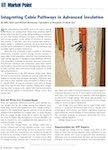We're taking a different tack on this post. I'd like to welcome Sean Lintow, Sr. of SLS Construction in Cullman County, Alabama as our first guest to post on Tech Rumblings and the Home.
Sean's at the helm of this family owned business serving northern Alabama but his footprint extends far beyond the sales territory. Sean is an opinion leader who reaches past great quality construction for his clients by thoroughly researching everything that his projects touch to ensure that he and his team are most up-to-date and provide reliable counsel to customers and colleagues. In short, he's keen to be knowledgeable and places high value on doing things well...a good example for others to aspire to. In fact, as I write this brief introduction, Sean is packing his bags for a multi-day training session on Infrared Thermography, adding more tools and techniques to his kit that will help diagnose construction flaws and lead to dramatic improvements in the built environment for those lucky enough to hire him. To learn more about Sean and SLS Construction be sure to add his blog to your reading list: Homeowner's Resource Center
Sean, in addition to expertise in residential design and construction, has deep experience in information technology and network security, making him uniquely qualified to contribute to today's posting. Sean stretches from bits and bytes to characteristics of today's construction materials and understands how intricately woven all building systems are.
Please welcome Sean and enjoy this piece.
Do We Really Need Wires Anymore?
Let me see if I got this straight, you want me to install eXapath conduit in my walls to help future proof my home for low voltage wiring used for telephone, internet, audio, security and TV connections? In case no one told you, they have wireless devices now, so isn’t going wireless truly the wave of the future? Do we really need wires anymore?
You can admit it; you were wondering about it or had the same thoughts. So, is wiring really dead?
In our recent Remodeling Right: A Hedge Against Changing Technology article we mentioned a great product (eXapath) for running low voltage cabling in your walls. This wiring is used for everything from alarm systems, to your telephone, from your internet connection, to your television. Some people have questioned this by simply asking – "isn’t wireless truly the wave of the future?"
For many that have connected with me on
LinkedIn, you may have noticed that I also have a background in the Information Technology field. Based not only on my IT experience, but knowledge of the newer building technologies being used “going wireless” might cost you more than you think. While wireless technology is a good solution for numerous issues, one must realize that with any technology there are limits.
Security:
- Wireless Routers – Many consumers simply hook up their new wireless router using the factory set defaults and just leave it.
- Most default setups do not use encryption, so all the information is sent in clear text. That includes your passwords, your emails, etc…
- Did you change the administrator name and password? Most routers password and admin names are well known
- When was the last time you reviewed the router logs & checked for updates? While many people like to think that these devices are plug & forget – they are far from it
- Cellular Phones & regular wireless phones
- You can buy a radio scanner & listen in on your neighbor’s calls.
- Do they have one of the newer CDMA or GSM cell phones or one of the new wireless ones with channel hopping technology? I hate to tell you this, but that technology has already been cracked and can be gotten off the internet.
Signal Disturbance:
- Natural Disturbances: For one example, I have DirecTV at my house. One of the biggest issues is that when a tornado warning is going off, I generally cannot see where the storm is headed, because the rain and clouds have blocked the satellite signal. While this affects line of site communications, electrical storms can also disturb your wireless signals.
- Microwave ovens and other consumer electronics can also emit noise in the same frequencies and can disrupt your signal.
- Wireless jammers, while outlawed by the FCC, can still easily be purchased online.
Speed and Capacity:
- Wireless Routers utilize what is known as a common signal. As more equipment connects to the access point, the signals are shared and the data rate provided for each device drops dramatically.
- Pretty soon all your appliances, TV’s, DVR’s, HVAC systems will be “online” allowing for manufacturers to send a repair tech out before you know you need them, or allowing you to connect to them while you are away from home.
- Can you imagine the bandwidth being used when your wife is watching a streamed movie, kids are playing online while downloading songs, and you are telecommuting?
- Wireless is still playing catch up – while the latest 802.11n standard promises data transfer of 300 Mbps (compared to 1000 MBPS for the newer wiring) you need to read the fine print attached.
Actual data throughput will vary. Network conditions and environmental factors, including volume of network traffic, buildings materials and construction, and network overhead, lower actual data throughput rate. Environmental factors will adversely affect wireless signal range.
Building Materials and Construction:
I am sure this has happened to you while talking on the cell phone, the person you are speaking to goes “sorry I am going through a tunnel,” “sorry I am losing you” or something similar. Part of this issue is that the signal cannot penetrate the structure or the signal can only travel so far. This issue also applies to today’s houses and buildings. If the building is spread out, contains multiple stories, if there is a lot of concrete, metal, radiant barriers, etc… it can interfere with your signal.
The cost:
Cost can actually play a big factor in your decision process. While you can pick up a router for next to nothing, they make their money up on the Wireless cards you need to buy for each piece of equipment. If you have a laptop only, you might not have to worry about it, but getting a card for your PC, DVR, X-Box 360, refrigerator, etc… it can add up real quick.
Wireless Signals are Not Green?
If you are building and pursuing
Minnesota GreenStar certification, arguably the most progressive and detailed green-build program in the US, you might want to forget the word wireless all together…
11-B-12: Install CAT-5e (enhanced) or CAT-6 shielded data cable throughout house to every room where computers and telephones will be used. Avoid Wi-Fi. Use hardwired, corded telephones rather than cordless telephones.
The reasoning:
The recommendations here are based upon safe exposure guidelines accepted by regulatory agencies, particularly in Europe, dedicated to protecting human health from harmful exposure to man-made electrical and magnetic fields (EMF) as well as radio frequencies (RF). The information here may be viewed as controversial since the primary data pointing to concern is coming from Europe. Yet, health researchers in the United States are actively pursuing research in this area.
Because EMF exposure has potential links to headaches, ear and eye problems, memory problems, sleep disturbance (and the physical ailments that come from sleep deprivation), and cancer, we are using what is called the “precautionary principle”— if there is sufficient evidence that there could be harm from exposure to an influence and that exposure cannot be proven to be safe beyond a shadow of a doubt, then precautions need to be taken by the public to protect human exposure to that influence until safety can be firmly established.
Now like most homeowners, I am really getting tired of hearing the “XY or Z may harm you” arguments. I cannot think of one item that will not supposedly cause harm, but there is ample evidence that these electromagnetic fields exist and that they have caused issues with certain individuals. While the Minnesota program is the only one I know of that has this as part of their standards right now, it may be adopted by other “green” programs in the near future.
The Verdict
So should I take it that wireless is bad, and there is no place for it? No, it is a great technology that solves many problems, is easy to setup, and it will be here for many years to come. However, if you do not understand the issues, or its limitations, you may be disappointed at its performance or in for a shock when your banking information is “stolen”. If used appropriately though, one can use both types of hard wired and wireless systems in a complementary fashion and leave room to adapt with change.
An Update
Subsequent to this posting an interesting article was posted by CNN on inadvertent activity undertaken by the troupe of Google "Street View" cars that roam around collecting image and geo-location information. Using open (not password protected) WiFi networks they routinely collected web visit history from WiFi network users. See the entire article here.









.jpg)

